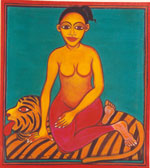Contribute
| In Conversation With Shula Reinharz |
Nirmala Garimella
10/01/2007
Shulamit (Shula) Reinharz is the Jacob Potofsky Professor of Sociology at Brandeis University.Director of the Brandeis University Women’s Studies Program during the decade of the 90’s, she founded the Hadassah-Brandeis Institute in 1997. She spoke to Lokvani about the upcoming event at Brandeis University titled 'Tiger by the Tail! Women Artists of India Transforming Culture' an exhibit that runs from October till December . What was the idea behind this event? Which myths/beliefs in women's lives does the exhibition hopes to discuss or portray? Are the works far from the traditional representation of Perhaps the most interesting Artist in terms of using traditional representations of Indian women in new ways is Nalini Malani, who created a vidoe she calls Unity in Diversity that reworks the well known late 19th century painting Galaxy of Musicians (1893) by Raja Ravi Varma. As the ground for her commentary on the atrocities of the Gujarat genocide of 2002, Malani has been honored recently with the largest single exhibition at the Venice Biennale and a retrospective at the Dublin National Musuem. In the words of one of the curators, Dr. Elinor Gadon, "These artists are transforming the myths on which the traditional iconography is based. They are confronting oppressive beliefs and creating a new mythology for the empowerment of women." By challenging the 2000-year old tradition of representing the female only as a symbol of fertility and beauty, they are bringing to the fore other facets of her self, and treating the woman as a whole human being.Another thing I noticed in the art is that many of these women, but particularly Mithu Sen, celebrate the power of women’s bodies and the auspiciousness of their sexuality. To know more about the exhibit goto http://www.brandeis.edu/centers/wsrc/arts/currentexhibitions.html
In 2001 Shula left the Women’s Studies Program to launch the Women’s Studies Research Center in a 10,000 square foot facility on campus that she designed and for which she raised all of the funds.Born in Amsterdam, the child of Holocaust survivors, Shula grew up in the United States and has also lived in Israel. She received her B.A. from Barnard College and her M.A. and Ph.D. from Brandeis University.
Shula is the author and editor of many books. Shula is the mother of two daughters, Yali and Naomi, and is married to Jehuda Reinharz, President of Brandeis University.
I am the director of the Women's Studies Research Center (WSRC) at
There are 17 artists and 32 works of art in this show, including sculpture, painting, video and installation. Although each work of art addresses a different topic, there are numerous themes which groups of artists address. These deal with transforming myths; subverting icons; performing the body; memory, loss, trauma, and the location of violence; issues of identity; empowerment and healing.
Navjot Altaf deals with women controlling their own fate in her sculpture, and in her video she deals with the loss she feels upon becoming a widow, particularly the loss of her husband's touch. In our catalogue, Navjot wrote, "My work...questions various frameworks of social injustice and violence...in the intimate, often hidden private lives of women. My sculptures...address the burning questions of the inequalities that exist in society, especially as concerns the female of the species. Kanchan Chander's sculptures deals with men's violence toward women.
Many of the issues are the same - the need for opportunities to work and to advance; the need for child care, health care, protection from violence, political representation; but some of the issues are more pronounced in India, such as illiteracy, poverty and female infanticide or foeticide. Dr Gadon’s view is that feminism in
What has been the response from the public and the community for this program?
Extraordinary enthusiasm and interest. Most people are not familiar with this work and want to learn about it. There are many Indian students and faculty at Brandeis and they are happy to have a show that deals with "home."
You may also access this article through our web-site http://www.lokvani.com/

